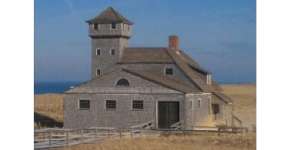7. Life Saving Stations


The United States Coast Guard is noted for many accomplishments; foremost in the public’s mind is the Service’s efforts helping those “in peril upon the seas”. One of the predecessors of today’s U.S. Coast Guard was the U.S. Life-Saving Service (LSS), which had an important presence on Cape Cod from 1872 until 1915, when it became part of the newly-formed U.S. Coast Guard. The Life-Saving Stations built by the U.S. LSS continued to operate under the Coast Guard as late as 1955, when the Chatham Life-Saving Station was the last to be decommissioned.
Four Life Saving Stations were located in Chatham - their former approximate locations are shown on the eTour map with pins labeled 7a, 7b, 7c, and 7d.
- Chatham Life-Saving Station, located at Morris Island Beach, was built in 1872. A new Chatham 300 plaque is located at the Monomoy Wildlife Refuge visitors center on Morris Island, and tells more of the story of the Chatham LSS, also known as Life-Saving Station #13, and later as Coast Guard Station #42.
- Old Harbor Station was located on North Beach, across from Ministers Point; it was built in 1897, and decommissioned in July 1944. It was moved to Provincetown in 1977 to become a museum at the Cape Cod National Seashore. Breeches buoy rescue re-enactments are conducted on the grounds on Thursday evenings in the summer.
- Monomoy Station, located on Monomoy north of the Monomoy Light, was built in 1872; it was decommissioned in 1923 at the same time the Monomoy Light was taken out of service.
- Monomoy Point Station, on the south tip of Monomoy, was built in 1902; it was also decommissioned in 1923. Located at the extreme end of Monomoy, it was intended to replace the Monomoy Station, but after what became known as the "Monomoy Disaster" (the Wadena barge rescue gone wrong) in March of 1902, it was decided to continue service from both stations.
In addition to huts used for shelter by stranded mariners, early efforts at assisting ships in distress were lifeboat stations along the shore, manned by volunteers. In 1870, disastrous winter storms caused a horrendous number of deaths from maritime disasters along the Atlantic coast. This started a period of building better lifeboat stations with paid crews. In 1878 the growing network of lifesaving stations was organized as a separate agency of the Treasury Department and named the U.S. Life-Saving Service. Its motto was “You have to go out, but you don’t have to come back”.
The original Life-Saving Service was separate from the U.S. Lighthouse Service, which operated three lighthouses in Chatham. The Life-Saving Service was merged with the US Cutter Revenue Service in 1915 to form the US Coast Guard, and the Lighthouse Service was later merged into the Coast Guard, in 1939. The formation of the Coast Guard Service in 1915 did not change the mission of the Life-Saving Stations, only the name of organization which operated them. It was other factors that caused the closure and consolidation of Chatham’s Life-Saving Stations. The opening of the Cape Cod Canal in 1914 caused a reduction of shipping traffic south of Monomoy. Motorized lifeboats and other technological advancements allowed fewer stations to cover a larger territory. All the other Chatham stations were consolidated at the Chatham Station on Morris Island by 1944, when the wildlife refuge was created on Monomoy. A transition period followed, and by 1955 all search and rescue operations had been consolidated into the Coast Guard operations at the Chatham Light. Today the mission of helping those “in peril upon the seas” remains, now performed by Coast Guard Station Chatham.
 Prev
Prev